Thomas James Richards, Diaries, Transcript Vol. 4, 9 November 1916 - 31 May 1918 - Part 31
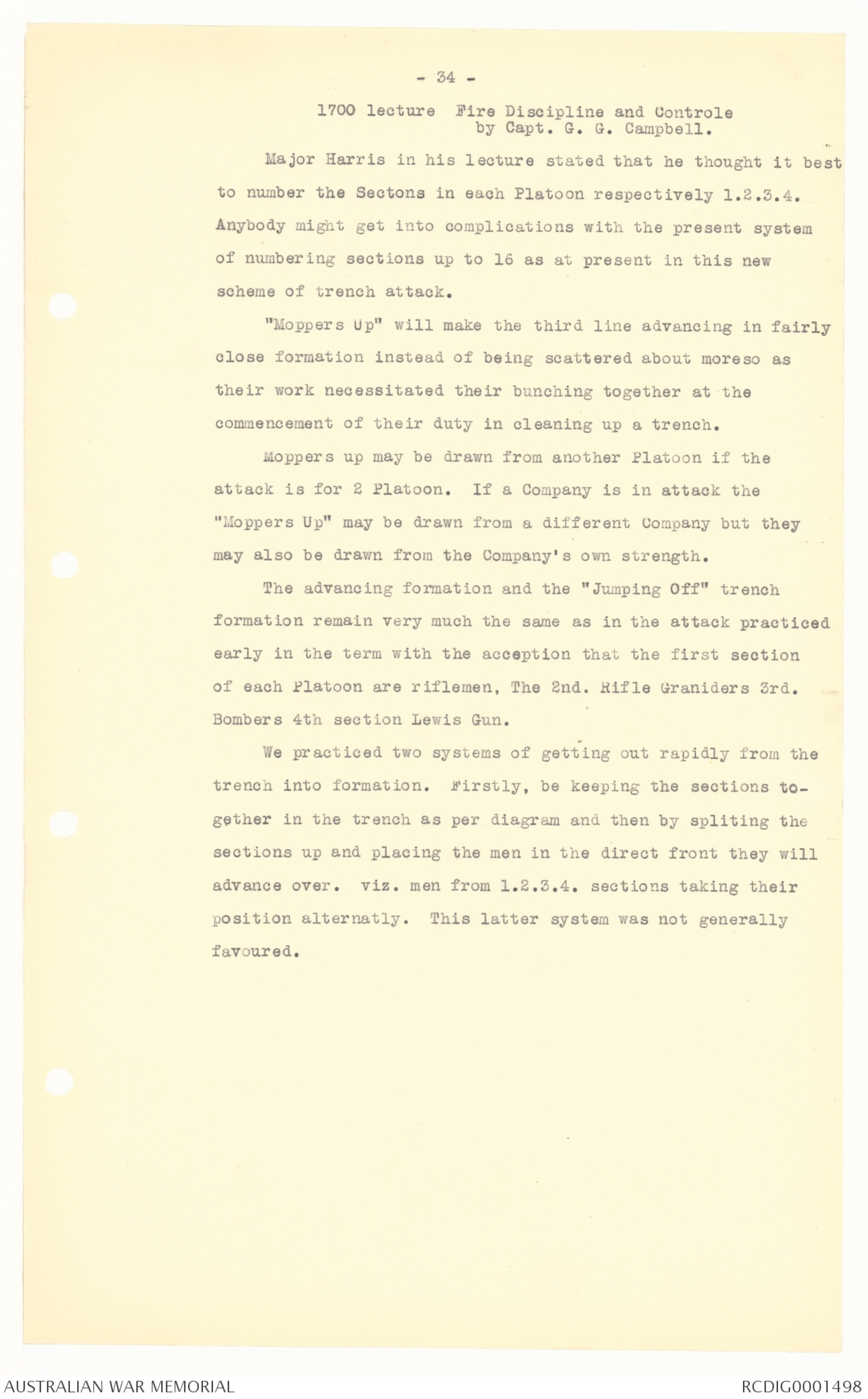

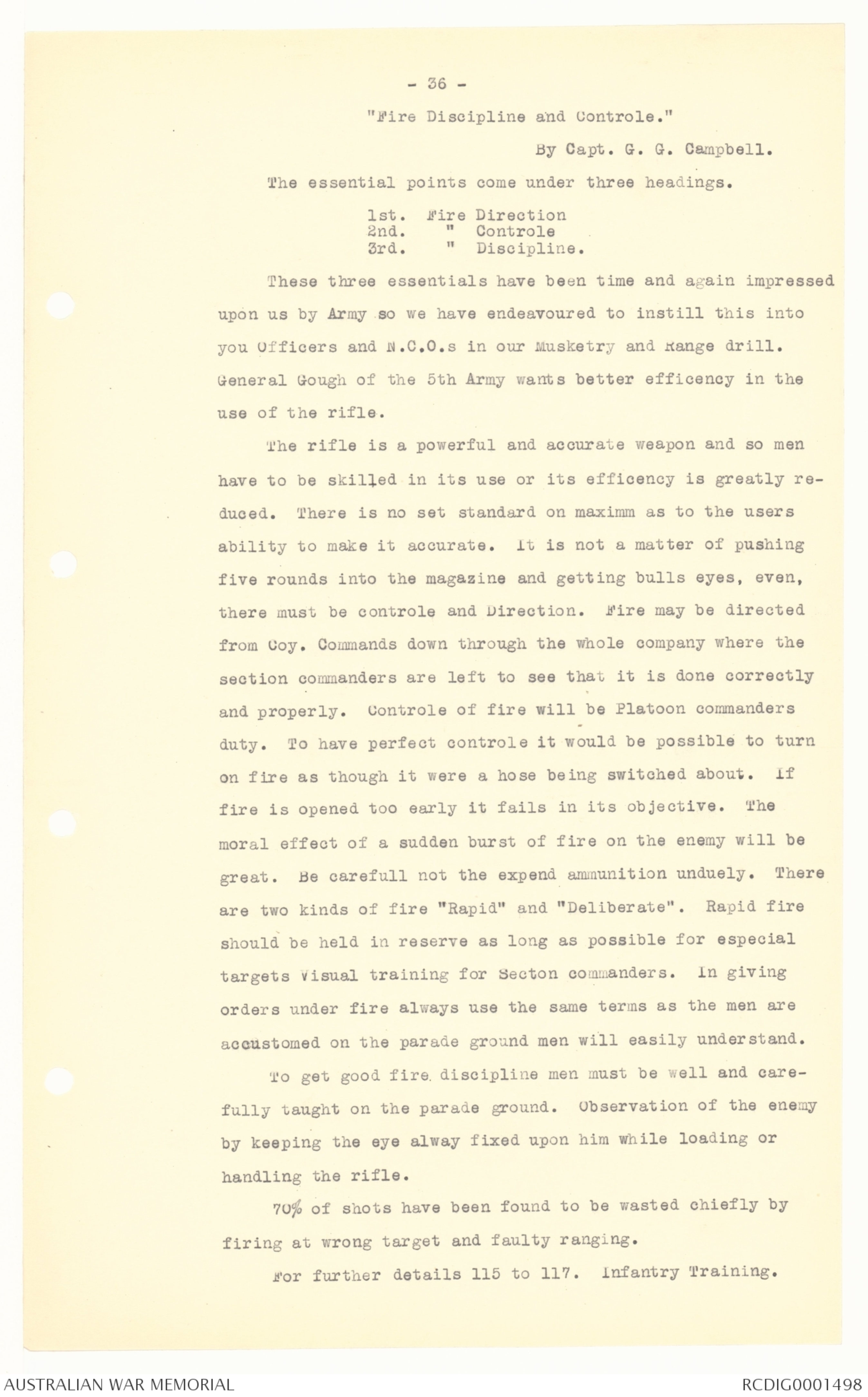

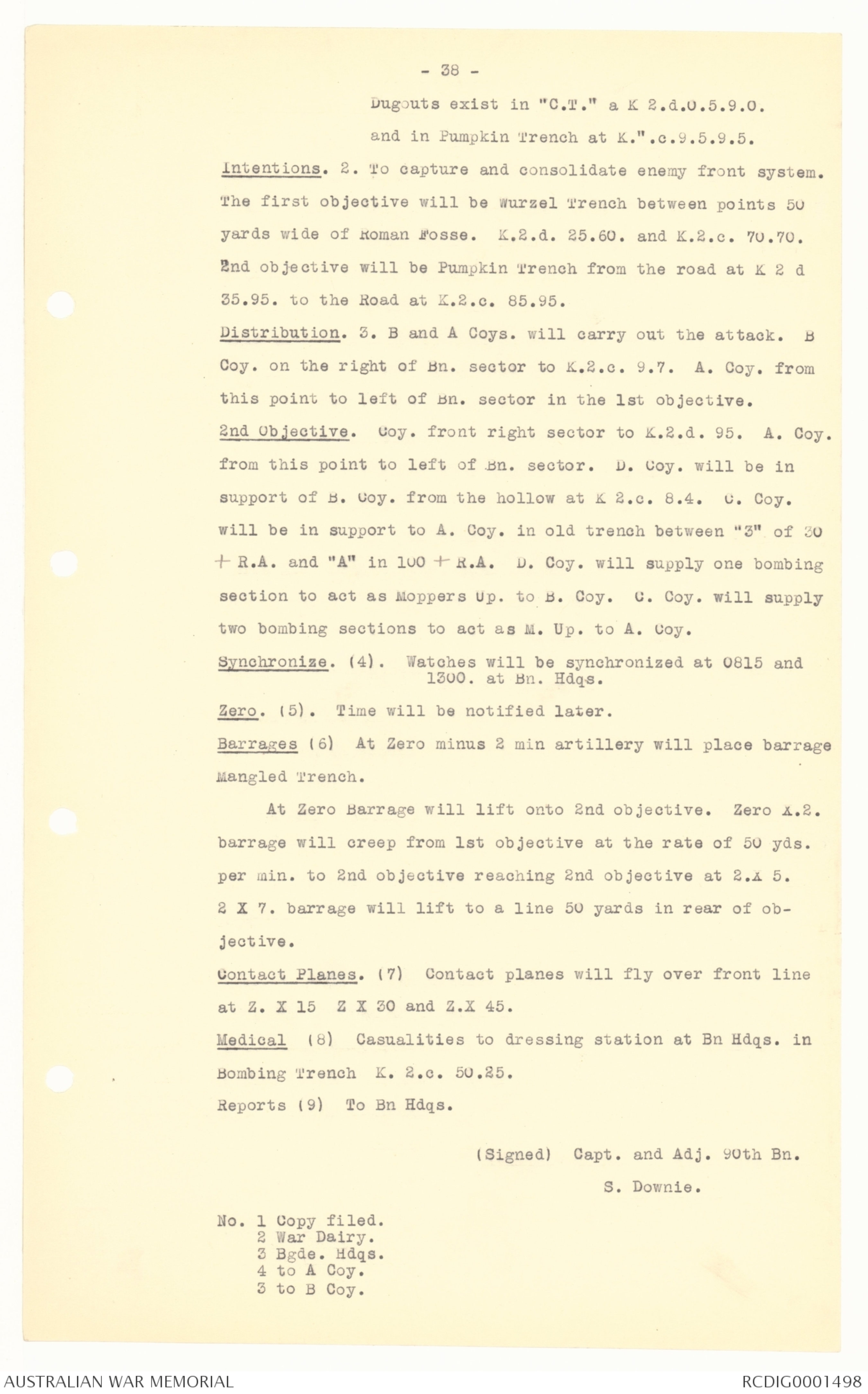
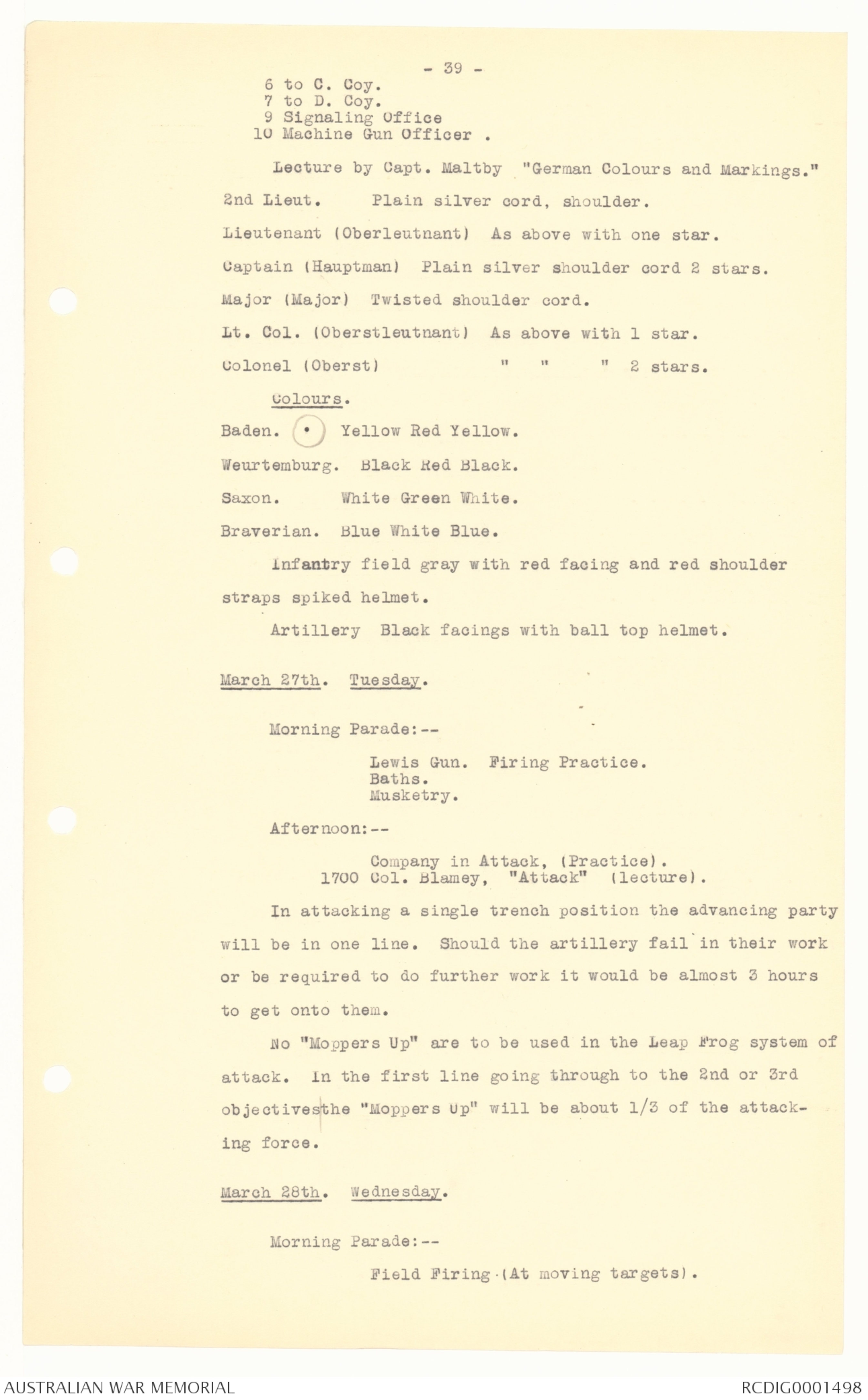

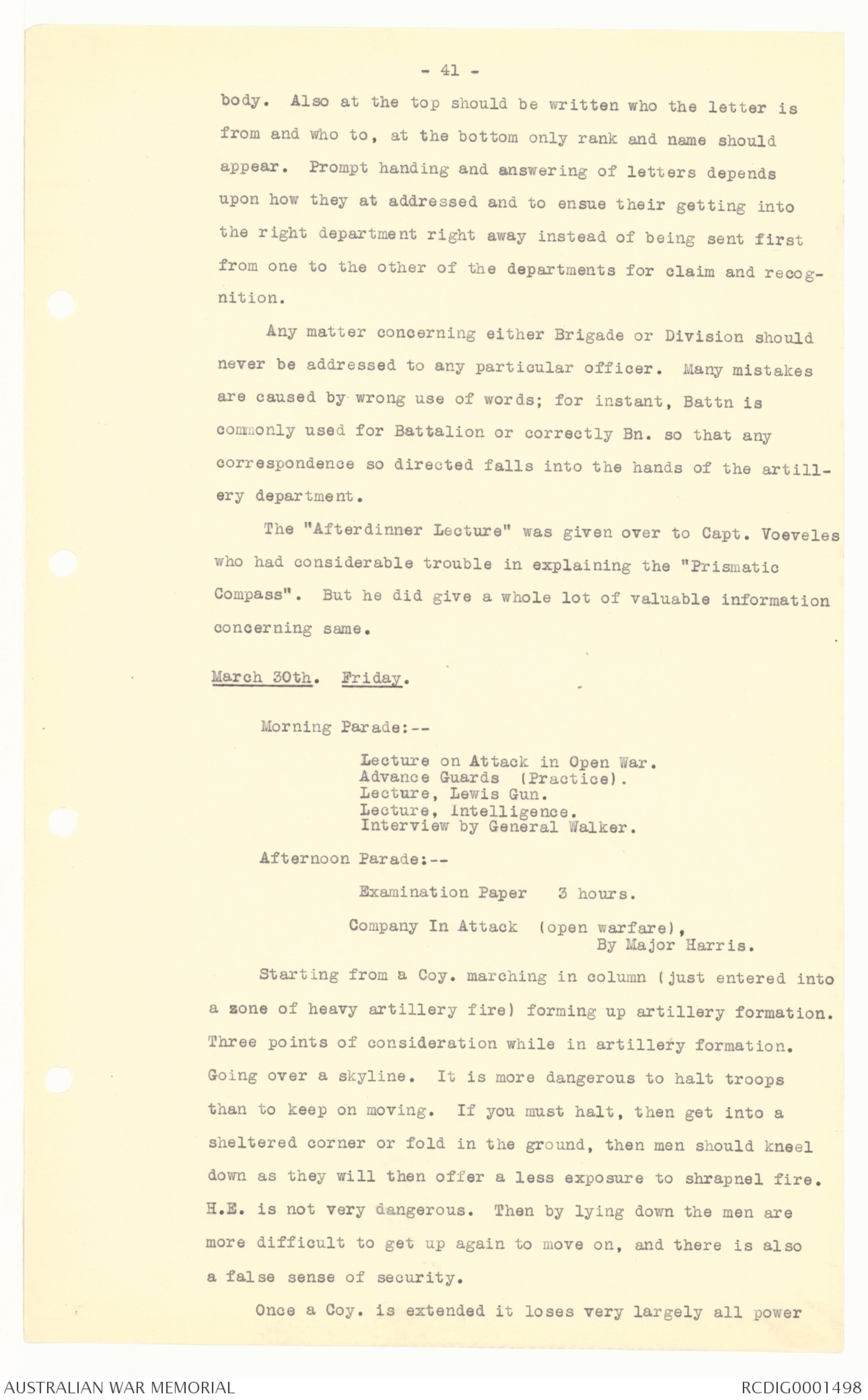

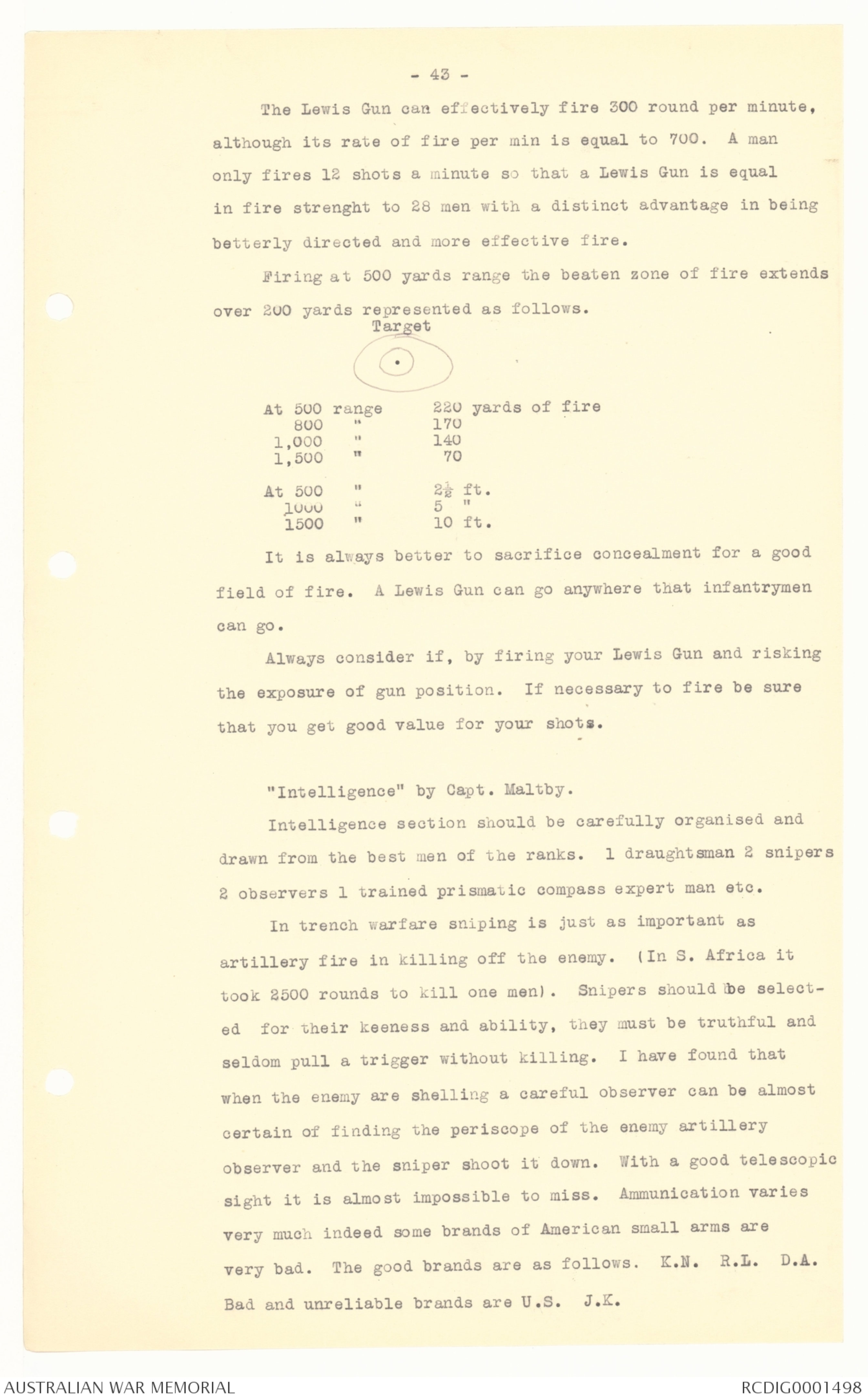
- 34 -
1700 lecture Fire Discipline and Controle
by Capt. G. G. Campbell.
Major Harris in his lecture stated that he thought it best
to number the Sectons in each Platoon respectively 1.2.3.4.
Anybody might get into complications with the present system
of numbering sections up to 16 as at present in this new
scheme of trench attack.
"Moppers Up" will make the third line advancing in fairly
close formation instead of being scattered about more so as
their work necessitated their bunching together at the
commencement of their duty in cleaning up a trench.
Moppers up may be drawn from another Platoon if the
attack is for 2 Platoon. If a Company is in attack the
"Moppers Up" may be drawn from a different Company but they
may also be drawn from the Company's own strength.
The advancing formation and the "Jumping Off" trench
formation remain very much the same as in the attack practiced
early in the term with the acception that the first section
of each Platoon are riflemen, The 2nd. Rifle Graniders 3rd.
Bombers 4th section Lewis Gun.
We practiced two systems of getting out rapidly from the
trench into formation. Firstly, be keeping the sections together
in the trench as per diagram and then by spliting the
sections up and placing the men in the direct front they will
advance over. viz. men from 1.2.3.4. sections taking their
position alternatly. This latter system was not generally
favoured.
- 35 -
Attack Two Platoon Front.
| 1st. Line |
8 Bombers |
Sgt. |
8 Rifle |
|
Riflemen |
Stg. |
Bombers |
) |
|
7 |
2 |
5 |
|
1 |
1 |
3 |
) 1st. Wave | |
| 2nd. Line |
L G Team |
Plat. Comm. |
8 R. Bombs |
|
R. Bombs |
Plat. Comm. |
L. G. |
) ) |
|
8 |
|
6 |
|
2 |
|
4 |
||
| 3rd. Line | Moppers Up | Moppers Up | ||||||
|
|
|
|
Coy. |
Comm. |
|
|
|
|
|
Bombers |
Plat. Sgt. |
Rifle |
|
Riflemen |
|
Bombs |
|
|
|
15 |
4 |
13 |
|
9 |
|
11 |
|
|
|
|
|
|
|
|
3 |
|
|
|
|
L. G.Team |
R. Bombs |
|
|
R. B. |
|
L G |
|
|
|
16 |
14 |
|
|
10 |
|
12 |
|
|
|
In |
Trench | |||||||
| 8 765 | M.U. | 16.15.14.13. | Hdqs. | 9 10 11 12 | M.U. | 1234 | ||
|
Platoon and Sgts. |
Plat. Com. " Stg. |
- 36 -
"Fire Discipline and Controle."
By Capt. G. G. Campbell.
The essential points come under three headings.
1st. Fire Direction
2nd. " Controle
3rd. " Discipline.
These three essentials have been time and again impressed
upon us by Army so we have endeavoured to instill this into
you Officers and N.C.O.s in our Musketry and Range drill.
General Gough of the 5th Army wants better efficency in the
use of the rifle.
The rifle is a powerful and accurate weapon and so men
have to be skilled in its use or its efficency is greatly reduced.
There is no set standard on maximm as to the users
ability to make it accurate. It is not a matter of pushing
five rounds into the magazine and getting bulls eyes, even,
there must be controle and Direction. Fire may be directed
from Coy. Commands down through the whole company where the
section commanders are left to see that it is done correctly
and properly. Controle of fire will be Platoon commanders
duty. To have perfect controle it would be possible to turn
on fire as though it were a hose being switched about. If
fire is opened too early it fails in its objective. The
moral effect of a sudden burst of fire on the enemy will be
great. Be carefull not the expend ammunition unduely. There
are two kinds of fire "Rapid" and "Deliberate". Rapid fire
should be held in reserve as long as possible for especial
targets Visual training for Secton commanders. In giving
orders under fire always use the same terms as the men are
accustomed on the parade ground men will easily understand.
To get good fire discipline men must be well and carefully
taught on the parade ground. Observation of the enemy
by keeping the eye alway fixed upon him while loading or
handling the rifle.
70% of shots have been found to be wasted chiefly by
firing at wrong target and faulty ranging.
For further details 115 to 117. Infantry Training.
- 37 -
March 25th. Sunday.
Morning Parade:-- 9.30 to 10.45.
Church Parade.
Leave to visit Amiens from 11. O'clock.
I have heard that the only building left standing at
Bapaume was the old Town Hall. Our troops and a Comfort
Fund people went into it and five days after the Germans
left it they blew it up with a contact mine. About 40 persons
being injured. This goes to show clearly that the
German can never be trusted at any time. So if biscuits are
found for instance rest assured they are poisoned. If anything
is found at all just ask yourself the question as to
why he left them behind.
March 26th. Monday.
Morning Parade:--
(Raining heavily) Discussion of Attack
and orders of the operation.
Lecture on Orders.
Lewis Gun stoppages.
Afternoon Parade:--
Practicable laying out of trenches.
Visual training and Communication practice.
Lecture Capt. Maltby. "German Colours and
Markings."
Owning to the weather the scheme of a Company in attack
was carried out.
The Battalion Operation Orders read as follows:--
90th Battalion.
Ref. Map ROMAN CAMP 1/180,000
Operation Order No. 17. 25 - 3.17.
by
Lt. Col. R. H. Fritzshrapnel Commanding
Information. 1. Enemy's front system consists of three lines
of trenches. 1st. line is known as MANGELD
Trench 2nd. line WURZEL Trench 3rd. PUMPKIN
Trench. These are connected by ttwo communication
trenches 200 yards apart. Mangled
trench has been rendered untenable by shell
fire and is unoccupied. According to our
report 2nd and 3rd lines are strongly held.
- 38 -
Dugouts exist in "C.T." a K 2.d.0.5.9.0.
and in Pumpkin Trench at K.".c.9.5.9.5.
Intentions. 2. To capture and consolidate enemy front system.
The first objective will be Wurzel Trench between points 50
yards wide of Roman Fosse. K.2.d. 25.60. and K.2.c. 70.70.
2nd objective will be Pumpkin Trench from the road at K 2 d
35.95. to the Road at K.2.c. 85.95.
Distribution. 3. B and A Coys. will carry out the attack. B
Coy. on the right of Bn. sector to K.2.c. 9.7. A. Coy. from
this point to left of Bn. sector in the 1st objective.
2nd Objective. Coy. front right sector to K.2.d. 95. A. Coy.
from this point to left of Bn. sector. D. Coy. will be in
support of B. Coy. from the hollow at K 2.c. 8.4. C. Coy.
will be in support to A. Coy. in old trench between "3" of 30
+ R.A. and "A" in 100 + R.A. D. Coy. will supply one bombing
section to act as Moppers Up. to B. Coy. C. Coy. will supply
two bombing sections to act as M. Up. to A. Coy.
Synchronize. (4). Watches will be synchronized at 0815 and
1300. at Bn. Hdqs.
Zero. (5). Time will be notified later.
Barrages (6) At Zero minus 2 min artillery will place barrage
Mangled Trench.
At Zero Barrage will lift onto 2nd objective. Zero X.2.
barrage will creep from 1st objective at the rate of 50 yds.
per min. to 2nd objective reaching 2nd objective at 2.X 5.
2 X 7. barrage will lift to a line 50 yards in rear of objective.
Contact Planes. (7) Contact planes will fly over front line
at Z. X 15 Z X 30 and Z.X 45.
Medical (8) Casualities to dressing station at Bn Hdqs. in
Bombing Trench K. 2.c. 50.25.
Reports (9) To Bn Hdqs.
(Signed) Capt. and Adj. 90th Bn.
S. Downie.
No. 1 Copy filed.
2 War Dairy.
3 Bgde. Hdqs.
4 to A Coy.
3 to B Coy.
- 39 -
6 to C. Coy.
7 to D. Coy.
9 Signaling Office
10 Machine Gun Officer
Lecture by Capt. Maltby "German Colours and Markings."
2nd Lieut. Plain silver cord, shoulder.
Lieutenant (Oberleutnant) As above with one star.
Captain (Hauptman) Plain silver shoulder cord 2 stars.
Major (Major) Twisted shoulder cord.
Lt. Col. (Oberstleutnant) As above with 1 star.
Colonel (Oberst) " " " 2 stars.
Colours.
Baden. ⨀ Yellow Red Yellow.
Weurtemburg. Black Red Black.
Saxon. White Green White.
Braverian. Blue White Blue.
Infantry field gray with red facing and red shoulder
straps spiked helmet.
Artillery Black facings with ball top helmet.
March 27th. Tuesday.
Morning Parade:--
Lewis Gun. Firing Practice.
Baths.
Musketry.
Afternoon:--
Company in Attack, (Practice).
1700 Col. Blamey, "Attack" (lecture).
In attacking a single trench position the advancing party
will be in one line. Should the artillery fail in their work
or be required to do further work it would be almost 3 hours
to get onto them.
No "Moppers Up" are to be used in the Leap Frog system of
attack. In the first line going through to the 2nd or 3rd
objectives the "Moppers Up" will be about 1/3 of the attacking
force.
March 28th. Wednesday.
Morning Parade:--
Field Firing (At moving targets).
- 40 -
Lewis Gun. Stoppages (practice)
Artillery formations.
Afternoon Parade:--
Football match.
This Lewis Gun practice is very good indeed. We must
by now all have a good working knowledge of the Gun and its
makeup. I find the gun is a wonderful weapon; the manner in
which it is put together is splendid. Its uses in either
defense or attack can be made very valuable, even more
valuable than we had previously behind.
March 29th. Thursday.
Morning Parade:--
Scheme of Defense (lecture)
" " practice and sketch.
Afternoon Parade:--
Discussion of this morning scheme by Major
Harris.
Football match against 4th Division School.
1st won 9 - 0.
1700 Lecture on Correspondence by Capt. Fay.
After dinner lecture. Prismatic Compass.
The morning scheme was laid down, as follows. Enemy at
St. Savious. N. Brigade to hold front from "B" in Brailly
to windmill West of St. Vaast.
X. Bn. from right bank of River Somme to Wood 1 mile South
of St. Vaast.
"Y". Bn. on the right of "X." B. and "W" on left.
"A" Coy. X. Bn from the right to 100 yds. N of La Chassee. Road
B. Coy. X. Bn 100 yds. of La Chassee Rd. to "C" in Roman Camp.
Line to be held at all cost.
Lecture "Correspondence" Capt. Fay.
Strict attention must be paid to every detail regarding
military correspondence. The different forms and kinds of
correspondence in Military affairs have to be carefully considered.
It is very necessary also to keep correspondence
down to a minimum, as is must alway be borne in mind that
Division has some 10 Battalions to deal with and it means
an immense amount of correspondence.
All letters addressed to a higher command should be on
1/4 margin "fool's cap" paper, and at the head of the letter
must be stated the roughly what is concerned in the letter
- 41-
body. Also at the top should be written who the letter is
from and who to, at the bottom only rank and name should
appear. Prompt handing and answering of letters depends
upon how they at addressed and to ensue their getting into
the right department right away instead of being sent first
from one to the other of the departments for claim and recognition.
Any matter concerning either Brigade or Division should
never be addressed to any particular officer. Many mistakes
are caused by wrong use of words; for instant, Battn is
commonly used for Battalion or correctly Bn. so that any
correspondence so directed falls into the hands of the artillery
department.
The "Afterdinner Lecture" was given over to Capt. Voeveles
who had considerable trouble in explaining the "Prismatic
Compass". But he did give a whole lot of valuable information
concerning same.
March 30th. Friday.
Morning Parade:--
Lecture on Attack in Open War.
Advance Guards (Practice).
Lecture, Lewis Gun.
Lecture, Intelligence.
Interview by General Walker.
Afternoon Parade:--
Examination Paper 3 hours.
Company In Attack (open warfare),
By Major Harris.
Starting from a Coy. marching in column (just entered into
a zone of heavy artillery fire) forming up artillery formation.
Three points of consideration while in artillery formation.
Going over a skyline. It is more dangerous to halt troops
than to keep on moving. If you must halt, then get into a
sheltered corner or fold in the ground, then men should kneel
down as they will then offer a less exposure to shrapnel fire.
H.E. is not very dangerous. Then by lying down the men are
more difficult to get up again to move on, and there is also
a false sense of security.
Once a Coy, is extended it loses very largely all power
- 42 -
of quick handling.
1st Phase; The breaking up of a column into artillery
formation.
2nd. Extended Order as the body draws nearer.
3rd. Commencing the fire fight followed by the bayonet
assult.
The fire fight may begin at a range of 1300 to 1400 yards
but it will frequently be possible to get within 8, or 900
yards and even closer before opening fire. Covering fire is
best made by the Lewis guns. The best support one Coy. or
Platoon can give another is to advance and ease their pressure
instantly. Rifle strength should one per yards in attacking
or holding a position.
During a fire fight troops should on no account be allowed
to dig in as, by so doing the advance is delayed and this
should always be carefully avoided.
Reorganisation should be at once commenced after an
attack which succeeds or not. But be careful not to reorganise
on the line the enemy were griven from as their artillery
will have it marked.
When one line reinforces another line they must not
stop but keep on going and be joined up by the forward line
moving ahead together.
4 cheif features:--
Advance in Artillery formation
Break down to Skirmishing order
Fire fighting
Bayonet assult.
Lecture on Lewis Gun.
1861 Gattling gun invented.
1866 French machine was invented but the war office
kept it secret so long that nobody know how to use it when
the war came on. It had an autamatic feed with 30 or 40
barrels.
Shields are used on their present guns by most other
nations but the British. This shields in some cases are very
heavy, and we find that a gun cannot be affetively concealed
or does the shield protect the gun from cross or enfilade
fire.
- 43 -
The Lewis Gun can effectively fire 300 round per minute,
although its rate of fire per min is equal to 700. A man
only fires 12 shots a minute so that a Lewis Gun is equal
in fire strenght to 28 men with a distinct advantage in being
betterly directed and more effective fire.
Firing at 500 yards range the beaten zone of fire extends
over 200 yards represented as follows.
Target
Diagram - see Original Document
At 500 range 220 yards of fire
800 " 170
1,000 " 140
1,500 " 70
At 500 " 2½ ft.
1000 " 5 "
1500 " 10 ft.
It is always better to sacrifice concealment for a good
field of fire. A Lewis Gun can go anywhere that infantrymen
can go.
Always consider if, by firing your Lewis Gun and risking
the exposure of gun position. If necessary to fire be sure
that you get good value for your shots.
"Intelligence" by Capt. Maltby.
Intelligence section should be carefully organised and
drawn from the best men of the ranks. 1 draughtsman 2 snipers
2 observers 1 trained prismatic compass expert man etc.
In trench warfare sniping is just as important as
artillery fire in killing off the enemy. (In S. Africa it
took 2500 rounds to kill one men). Snipers should bbe selected
for their keeness and ability, they must be truthful and
seldom pull a trigger without killing. I have found that
when the enemy are shelling a careful observer can be almost
certain of finding the periscope of the enemy artillery
observer and the sniper shoot it down. With a good telescopic
sight it is almost impossible to miss. Ammunication varies
very much indeed some brands of American small arms are
very bad. The good brands are as follows. K.N. R.L. D.A.
Bad and unreliable brands are U.S. J.K.
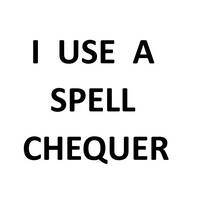 Not Yet Replaced By AI
Not Yet Replaced By AIThis transcription item is now locked to you for editing. To release the lock either Save your changes or Cancel.
This lock will be automatically released after 60 minutes of inactivity.